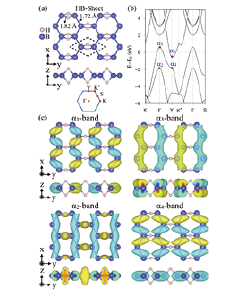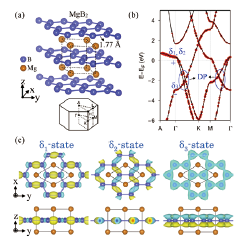Semi-Metallicity of Free-Standing Hydrogenated Monolayer Boron from MgB2
I. Matsuda Group
Two-dimensional monatomic layers in van der Waals crystals or on solid surfaces have wide attention because of their unique physical properties and potential applications in quantum devices. There has been growing interests in layers of Xenes. Recently, borophene layers were discovered and found to have Dirac fermions. However, in contrast to graphene, these Xene layers form only on solid surfaces. It is, thus, necessary to develop technique to passivate it chemically so it can be placed on any substrate under ambient conditions.

Fig. 1. (a) Atomic structure, and two-dimensional Brillouin zone of a HB sheet. (b) Calculated band structure. (c) Wave function distribution of the α1-, α2-, α3-, and α4-states. The color of wave functions corresponds to the sign of the periodic part of Bloch wave functions.

Fig. 2 (a) Atomic structure, and three-dimensional Brillouin zone of a MgB2 crystal. (b) Calculated band structure. The red dots are the projected band structure of MgB2 on B atoms. “DP” indicates Dirac point. Dirac points shown in (b) are “cross sections” of Dirac Nodal Loop. (c) Wave function distribution of the δ1-, δ2-, and δ3-states. In (c), the color of wave functions corresponds to the sign of wave functions.
In the present research, we synthesized a free-standing hydrogenated monolayer boron (HB) sheet and studied the electronic states via soft X-ray spectroscopy at the B K-shell absorption edge and the first-principles calculations [1]. As shown in Fig.1, the HB sheet is semi-metallic with electron and hole pockets at symmetry points of Γ and Y, respectively. The electron band results from the B-H-B bonds formed during synthesis from a MgB2 crystal, while the hole band is kept through the process and originates from a honeycomb lattice boron layer or borophene in MgB2. Figure 2 shows a summary of the calculation for a MgB2 crystal. One can find the one-to-one correspondence between wave-functions of the α1-state in HB and the δ2-state in MgB2. The present research reveals a relation between the surface treatment of monatomic layer and evolutions of the two-dimensional states, giving clues to design novel functional layers.
References
- [1] I. Tateishi, N. T. Cuong, C.A.S. Moura, M. Cameau, R. Ishibiki, A. Fujino, S. Okada, A. Yamamoto, M. Araki, S. Ito, S. Yamamoto, M. Niibe, T. Tokushima, D.E. Weibel, T. Kondo, M. Ogata, and I. Matsuda, Phys. Rev. Materials 3, 024004 (2019).
